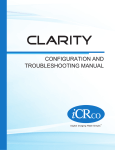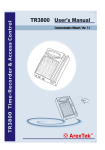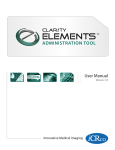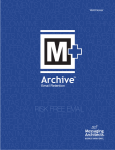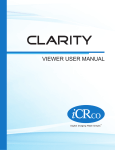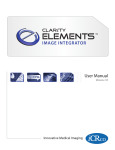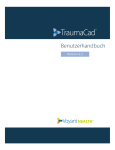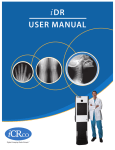Download Clarity Configuration and Troubleshooting
Transcript
Clarity PACSTM – Configuration & Troubleshooting Manual Contents 1 Introduction 2 2 System Requirements 3 3 Configuration 3.1 Static IP Configuration . . . . . . . . . . . . 3.1.1 Clarity 1 (Windows) . . . . . . . . . 3.1.2 Clarity+ and ClarityE (Linux) . . . . 3.2 Setting the hostname . . . . . . . . . . . . . 3.2.1 Clarity1 (Windows) . . . . . . . . . . 3.2.2 Clarity+ and ClarityE (Linux) . . . . 3.3 Determining the Clarity Archive hostname 3.3.1 Clarity1 (Windows) . . . . . . . . . . 3.3.2 Clarity+ and ClarityE (Linux) . . . . 3.4 launch.jnlp Configuration . . . . . . . . . . 3.4.1 Clarity1 (Windows) . . . . . . . . . . 3.4.2 Clarity+ and ClarityE (Linux) . . . . 3.5 Logging In . . . . . . . . . . . . . . . . . . . 3.6 Adding a New AE Title . . . . . . . . . . . . 3.7 Adding Users . . . . . . . . . . . . . . . . . 3.8 HL7 Configuration . . . . . . . . . . . . . . . . . . . . . . . . . . . . . . 4 4 4 7 9 9 9 9 9 10 10 10 11 11 12 12 12 . . . . . . . 14 14 14 14 17 17 17 17 . . . . 18 18 18 18 19 A Appendix A.1 Clarity+ and ClarityE (Linux) is Stuck At GRUB Boot Menu . . . . . . . . 21 21 4 5 . . . . . . . . . . . . . . . . . . . . . . . . . . . . . . . . . . . . . . . . . . . . . . . . . . . . . . . . . . . . . . . . . . . . . . . . . . . . . . . . . . . . . . . . . . . . . . . . Maintenance & Upgrades 4.1 Upgrading the Clarity Viewer . . . . . . . . . . . . . . 4.1.1 Clarity1 (Windows) . . . . . . . . . . . . . . . . 4.1.2 Clarity+ and ClarityE (Linux) . . . . . . . . . . 4.2 Back-up . . . . . . . . . . . . . . . . . . . . . . . . . . . 4.2.1 Clarity1 (Windows) . . . . . . . . . . . . . . . . 4.2.2 Clarity+ and ClarityE (Linux) . . . . . . . . . . 4.3 Uninstalling Clarity Viewer on a Viewer Workstation Trouble Shooting 5.1 Introduction . . . . . . . . . . . . . . . . 5.2 Diagnosis . . . . . . . . . . . . . . . . . . 5.2.1 Pre-Trouble Shooting Questions 5.3 Trouble Shooting . . . . . . . . . . . . . c ⃝2007, 2008 Confidential and Proprietary Property of iCRco, Inc. 1 of 21 . . . . . . . . . . . . . . . . . . . . . . . . . . . . . . . . . . . . . . . . . . . . . . . . . . . . . . . . . . . . . . . . . . . . . . . . . . . . . . . . . . . . . . . . . . . . . . . . . . . . . . . . . . . . . . . . . . . . . . . . . . . . . . . . . . . . . . . . . . . . . . . . . . . . . . . . . . . . . . . . . . . . . . . . . . . . . . . . . . . . . . . . . . . . . . . . . . . . . . . . . . . . . . . . . . . . . . . . . . . . . . . . . . . . . . . . . . . . . . . . . . . . . . . . . . . . . . . . . . . . . . . . . . . . . . . . . . . . . . . . . . . . . . . . . . . . . . . . . . . . . . . . . . . . . . . . . . . . . . . . . . . . . . . . . Document # CLY-02A Rev A August 3, 2009 Clarity PACSTM – Configuration & Troubleshooting Manual 1. Introduction The iCRco Clarity ArchiveTM is available either embedded with the CR acquisition computer (on Windows XP) or on a standalone server (on Linux) that can be configured for additional modalities and viewers as needed. Clarity ArchiveTM provides full DICOM storage and retrieval services, and allows DICOM-compliant software to retrieve or view the images over the network. Clarity ViewerTM is a web-enabled image viewer with a rich set of viewing and annotation tools. For the purposes of this document, “Clarity ArchiveTM ” will refer to the set of databases and program files that make-up the Clarity Archive; the term “Server” will refer to the hardware and operating system software (Windows or Linux) that Clarity ArchiveTM runs on. In the case where commands relating to the operating system are platform specific, it will be noted. “Clarity ViewerTM ” will refer to the Clarity ViewerTM software; the term “Client” will refer to the hardware and operating system the Clarity ViewerTM runs on. The term “Acquisition Station” will refer to any computer running DICOM-compliant software (QPC XSCAN32, Traumacad, etc.) that can send, query, or retrieve to/from Clarity ArchiveTM . c ⃝2007, 2008 Confidential and Proprietary Property of iCRco, Inc. 2 of 21 Document # CLY-02A Rev A August 3, 2009 Clarity PACSTM – Configuration & Troubleshooting Manual 2. System Requirements Server ∙ network connection ∙ static IP address ∙ firewall TCP ports 104 (DICOM), 8443 (Clarity launch page SSL port), and 11112 (Clarity Archive port) and UDP 137 (data transfer) to be open ∙ proper IP address, default gateway, and subnet mask configuration (this is heavily dependent on how the network is configured) Clarity Viewer Workstation ∙ 2 GHz Core2Due CPU ∙ ≥ 1 GB RAM ∙ Video card supporting at least 1280 x 1024 or 1024 x 768 with less information in the worklist ∙ Windows XP SP2 operating system ∙ network connection ∙ Java version 6 update 14 or later ∙ diagnostic quality monitor (required for primary diagnosis) Note: The theme service must be enabled and set to the Windows XP “Blue” Theme Acquisition Workstation ∙ DICOM compliant software to send/query/retrieve to/from Clarity Archive ∙ static IP address c ⃝2007, 2008 Confidential and Proprietary Property of iCRco, Inc. 3 of 21 Document # CLY-02A Rev A August 3, 2009 Clarity PACSTM – Configuration & Troubleshooting Manual 3. Configuration 3.1 Static IP Configuration 3.1.1 Clarity 1 (Windows) 1. Login as the Administrator. 2. Choose Start Menu→ Control Panel → Network Connections. Note: If your Control Panel looks like the one pictured below, click on the Classic View button, then select Local Area Connection Status. 3. In the Local Area Connection Status dialog box select Properties. 4. In the Local Area Connection Properties dialog box, select Internet Protocol (TCP/IP) and click the Properties button. c ⃝2007, 2008 Confidential and Proprietary Property of iCRco, Inc. 4 of 21 Document # CLY-02A Rev A August 3, 2009 Clarity PACSTM – Configuration & Troubleshooting Manual 5. In the Internet Protocol (TCP/IP) Properties dialog, select the option Use the following IP address. 6. Input static IP Address, Subnet Mask, and Default Gateway Address and click OK to continue. Note: If you do not know what to enter for these settings, please contact your System Administrator. Example settings: IP Address: 192.168.0.xxx Subnet Mask: 255.255.255.xxx Gateway Address: 192.168.0.xxx 7. Click the OK button on all the dialog boxes to save and close them. 8. Choose Start Menu→Shutdown → Restart to reboot server. Note: Review stations using only the Clarity Viewer do not need to be configured with a static IP address, although a static IP Address will work, it is not necessary. If QPC XSCAN32 is being used to retrieve images from the Clarity Archive, the XSCAN workstation will need a static IP Address. Additionally, QPC XSCAN32 c ⃝2007, 2008 Confidential and Proprietary Property of iCRco, Inc. 5 of 21 Document # CLY-02A Rev A August 3, 2009 Clarity PACSTM – Configuration & Troubleshooting Manual will need a DICOM target, and a new AE Title will need to be configured in the Clarity Archive web administration. 3.1.2 Clarity+ and ClarityE (Linux) 1. Go to System → Administration → Network. 2. A dialog box will ask for the “root” password (“root” is the Linux equivalent of a Windows Administrator account). Enter the root password. 3. Highlight the Device eth0, then click Edit 4. Select Statically Set IP Address, then enter the desired IP Address, Subnet Mask, and Default Gateway. Then click OK to save the changes. c ⃝2007, 2008 Confidential and Proprietary Property of iCRco, Inc. 6 of 21 Document # CLY-02A Rev A August 3, 2009 Clarity PACSTM – Configuration & Troubleshooting Manual 5. In the Network Configuration dialog, click on the DNS tab. 6. In the DNS tab, enter the relevant DNS information, then go to File → Save to save the changes. 7. Restart the network. Go to Applications → System Tools → Terminal, enter: service network restart then press Enter. c ⃝2007, 2008 Confidential and Proprietary Property of iCRco, Inc. 7 of 21 Document # CLY-02A Rev A August 3, 2009 Clarity PACSTM – Configuration & Troubleshooting Manual 3.2 Setting the hostname Note: The user may access ClarityPACS using a domain name, but the network must be properly configured. This is beyond the control of iCRco. For universal access, use the IP address. 3.2.1 Clarity1 (Windows) 1. Go to Start → Control Panel → System. 2. Click on the Computer Name tab, then click the Change. . . button. 3. In the Computer Name dialog, enter the desired hostname. 4. Click OK to apply the changes. 3.2.2 Clarity+ and ClarityE (Linux) 1. Go to System → Administration → Network 2. Click on the DNS tab 3. In the Hostname field, enter the desired hostname. 4. Go to File → Save to save the changes. 5. The network interface must be restarted to make the changes take effect. Go to Applications → System Tools → Terminal 6. In the terminal enter: service network restart 3.3 Determining the Clarity Archive hostname Note: The user may access ClarityPACS using a domain name, but the network must be properly configured. This is beyond the control of iCRco. For universal access, use the IP address. 3.3.1 Clarity1 (Windows) On the computer running the Clarity Archive: 1. Go to Start → Run and enter cmd in the Run dialog box. 2. In the Windows Command Prompt, enter hostname, then hit the Enter key. 3. The hostname will be returned. c ⃝2007, 2008 Confidential and Proprietary Property of iCRco, Inc. 8 of 21 Document # CLY-02A Rev A August 3, 2009 Clarity PACSTM – Configuration & Troubleshooting Manual 3.3.2 Clarity+ and ClarityE (Linux) On the computer running the Clarity Archive: 1. Go to Applications → System Tools → Terminal 2. In the Terminal window, enter hostname, then hit the Enter key. 3. The hostname will be returned. 3.4 launch.jnlp Configuration The launch.jnlp file needs to be configured to point to the right IP address for the Clarity Archive. 3.4.1 Clarity1 (Windows) Go to Start → All Programs → Clarity Archive → JNLP Configuration If the Viewer does not launch after the JNLP Configuration utility has been run, continue: 1. Go to: C:∖icrco∖dcm4chee-mysql∖server∖default∖deploy∖icrco-viewer.war 2. Locate the launch.jnlp. 3. Open launch.jnlp with a text editor (e.g. Notepad or Wordpad. Do not use Microsoft Word or another word processor). 4. Locate the string (near the top of the file): <jnlp spec="1.0+" codebase="https://IPADDRESS:8443/icrco-viewer/"> and replace ‘IPADDRESS’ with the IP address of computer. 5. Locate the string: <application-desc main-class="com.icrco.ui.client.Application"> and enter the IP address of the system in the second and third argument strings, like this: <application-desc main-class="com.icrco.ui.client.Application"> <argument>https</argument> <argument>IP ADDRESS</argument> <argument>IP ADDRESS</argument> <argument>8443</argument> 6. Save the file. c ⃝2007, 2008 Confidential and Proprietary Property of iCRco, Inc. 9 of 21 Document # CLY-02A Rev A August 3, 2009 Clarity PACSTM – Configuration & Troubleshooting Manual 3.4.2 Clarity+ and ClarityE (Linux) On Linux, the file will need to be edited by hand: 1. Go to: /clarity/server/default/deploy/icrco-viewer.war/ 2. Locate the launch.jnlp inside the icrco-viewer.war folder. Right click the launch.jnlp file, then choose Open in Text Editor. 3. Locate the string (near the top of the file): <jnlp spec="1.0+" codebase="https://IPADDRESS:8443/icrco-viewer/"> and replace ’IPADDRESS’ with the IP address of the computer. 4. Locate the string: <application-desc main-class="com.icrco.ui.client.Application"> and enter the IP address of the system in the second and third argument strings, like this: <application-desc main-class="com.icrco.ui.client.Application"> <argument>https</argument> <argument>IPADDRESS</argument> <argument>IPADDRESS</argument> <argument>8443</argument> 5. Save the file. 3.5 Logging In 1. Open the Firefox web browser (preferred) or Internet Explorer. 2. Enter: https://IPADDRESS:8443/clarityarchive in the browser’s address bar, where ’IPADDRESS’ is the IP address or IP address of the computer running the Clarity Archive. Note: The user will have to accept the browser security warnings to get to the Archive Login page. 3. At the login page, enter the username & password. c ⃝2007, 2008 Confidential and Proprietary Property of iCRco, Inc. 10 of 21 Document # CLY-02A Rev A August 3, 2009 Clarity PACSTM – Configuration & Troubleshooting Manual 3.6 Adding a New AE Title 1. Click on the AE Management link in the main navigation bar. 2. Click on the New AET button . 3. Enter the AE Title, IP Address, & Port number for the new AE Title. 4. Click the Create button to complete the AE Title setup. 5. Click the Echo button to test the new AE Title. Note: For DICOM-compliant software to retrieve from the Clarity Archive, a properly configured AE Title in the client program is required. Please consult the user manual for your particular software to configure an AE Title. 3.7 Adding Users 1. Click on the User Admin link in the main navigation bar. 2. Click on the New User button . 3. Enter the new username & password, then grant the user privileges by checking the desired boxes. Note: For new Users only using the Clarity Viewer, iCRco recommends only checking the box next to ’user.’ The ‘doctor’ user role allows users to write reports in the Clarity Viewer. 4. Click the Create button to complete the new user setup. 3.8 HL7 Configuration Clarity Archive is already configured to receive HL7 messages. The user must point the HL7 sending software at the IP address of the Clarity Archive using port 2575. The HL7 messages will populate the General Worklist. In this case, Clarity is acting only as a receiver of queries and information. Clarity will receive the HL7 message from the HIS/RIS/EMR, and store that information in the General Worklist. XSCAN (or any other DICOM-compliant software) can then query Clarity, and Clarity will pass on the information to XSCAN, and XSCAN will populate its database with the patient information. Note that the XSCAN Modality Worklist Query is a standard DICOM query, thus Clarity converts the HL7 message into DICOM format. c ⃝2007, 2008 Confidential and Proprietary Property of iCRco, Inc. 11 of 21 Document # CLY-02A Rev A August 3, 2009 Clarity PACSTM – Configuration & Troubleshooting Manual Clarity is configured to receive the following HL7 message types: ADT: A01, A04, A05, A08, A10, A23, A28, A31, A34, A40, A47 ORM: O01 MDM: T02, T10 ORU: R01 c ⃝2007, 2008 Confidential and Proprietary Property of iCRco, Inc. 12 of 21 Document # CLY-02A Rev A August 3, 2009 Clarity PACSTM – Configuration & Troubleshooting Manual 4. Maintenance & Upgrades 4.1 4.1.1 Upgrading the Clarity Viewer Clarity1 (Windows) Scope: This section describes how to upgrade the Clarity Viewer software running on Windows to a new version. Assumptions: 1. The Clarity Archive is installed and functioning normally. 2. The user has administrative privileges. Procedure: 1. Run Clarity Viewer.exe as provided by iCRco. 2. Run the JNLP Configuration utility. Go to Start → Programs → Clarity Archive → JNLP Configuration. 3. Reboot the computer for the changes to take effect. 4.1.2 Clarity+ and ClarityE (Linux) Scope: This section describes how to upgrade the Clarity Viewer software running on Linux to a new version. Assumptions: 1. The Clarity Archive is installed and functioning normally. 2. The user has administrative privileges. Procedure: 1. Open a Terminal. Navigate to Applications → System Tools → Terminal and left mouse click to open a Terminal Window. c ⃝2007, 2008 Confidential and Proprietary Property of iCRco, Inc. 13 of 21 Document # CLY-02A Rev A August 3, 2009 Clarity PACSTM – Configuration & Troubleshooting Manual 2. Gain root access. To gain root access, enter: su - in the Terminal, then press Enter. The Terminal will then ask for the password, which is clarity2008 by default (all lower case letters), then press Enter again after the password has been entered. 3. When the user has root access, the terminal should look like the one pictured below, with root instead of clarity 4. Stop the Clarity service. Enter: service clarity stop in the Terminal, then press Enter. Do not close the Terminal window. c ⃝2007, 2008 Confidential and Proprietary Property of iCRco, Inc. 14 of 21 Document # CLY-02A Rev A August 3, 2009 Clarity PACSTM – Configuration & Troubleshooting Manual 5. Locate the clarity folder in the root directory. Go to Places → Computer 6. Navigate to /clarity/default/deploy/ 7. In the deploy folder, copy over the new versions of icrco-viewer.war and icrco-viewerservices.war. The system will ask if the files should be over written. Choose Yes. 8. Start the Clarity service. Return to the Terminal window, then enter: service clarity start c ⃝2007, 2008 Confidential and Proprietary Property of iCRco, Inc. 15 of 21 Document # CLY-02A Rev A August 3, 2009 Clarity PACSTM – Configuration & Troubleshooting Manual 4.2 4.2.1 Back-up Clarity1 (Windows) iCRco provides one (1) 500 GB external drive for back-ups with the purchase of a Clarity system. The Clarity1 uses Windows XP’s built in back-up feature, located at Start → Programs → Accessories → System Tools → Backup. Friday at 11:55 PM is a full back-up, while Saturday to Thursday performs an incremental back-up. The user may change the back-up schedule by using the Windows Backup program, though iCRco recommends not changing the default backup scheme. 4.2.2 Clarity+ and ClarityE (Linux) iCRco provides one (1) 500 GB external drive for backups with the purchase of a Clarity system. The Clarity+ and ClarityE runs a cron job each night to perform a backup to the external drive, which is mounted in /backup. In addition, a cron job is also run once each hour to ensure that the external drive is mounted to /backup. Thus the user need only apply power to the external drive, and the system will mount and perform a backup with no user intervention. A full backup is performed Sunday morning at 4 a.m., while an incremental backup is made Monday to Saturday. In addition, a full backup is taken on the first day of every month. In addition, a nightly MySQL dump of the database is done before the regular back-up 4.3 Uninstalling Clarity Viewer on a Viewer Workstation To uninstall the Clarity Viewer, go to Start → Control Panel → Add or Remove Programs, then locate the iCRco Clarity program and click Remove. c ⃝2007, 2008 Confidential and Proprietary Property of iCRco, Inc. 16 of 21 Document # CLY-02A Rev A August 3, 2009 Clarity PACSTM – Configuration & Troubleshooting Manual 5. Trouble Shooting 5.1 Introduction The cause of some errors may be obvious. In these cases, the Technician may proceed directly to the fix. Before beginning an investigation, it is a good practice to record as much information about the current state of the system as possible. This information may include, but is not limited to, symptoms, conditions under which symptoms exist, network settings & general network configuration, when the system was last functional, and any recent changes made to the system. Normal, generic troubleshooting techniques apply: with knowledge of the system, isolate the failure to a particular subsystem. With knowledge of the subsystem, trace the symptom back to its cause. In many cases this solves the problem or provides clues as to the cause. The iCRco Clarity PACS system is most easily thought of as two pieces of software: the Clarity Archive & the Clarity Viewer. The Clarity Archive, available as an embedded system (Windows XP) or on a stand alone server (Linux), stores DICOM-compliant, medical-grade images and allows DICOM-compliant client software to retrieve or view the images over the network. The Clarity Viewer is a networked image viewer with a feature-rich set of annotation & manipulation tools. For purposes of troubleshooting, it is easiest to think of these two inter-related programs as separate entities. For the purposes of this document, the term “Clarity Archive” will refer to the set of databases and program files that actually make the Clarity Archive run; the term “server” will refer to the operating system software (be it Windows or Linux) and hardware that the Clarity Archive runs on. In the case where commands relating to the operating system are platform specific, it will be noted. The term “Clarity Viewer” will refer to the Clarity Viewer software; the term “client” will refer to the operating system software and hardware that the Clarity Viewer runs on. 5.2 5.2.1 Diagnosis Pre-Trouble Shooting Questions Many of the errors seen while using the Clarity software suite arise from simple misconfiguration. The following set of questions are designed to help solve misconfiguration problems. On the Server 1. Is there a USB security key in the server? Is it the correct key? The correct dongle will have a “Clarity” label on it. c ⃝2007, 2008 Confidential and Proprietary Property of iCRco, Inc. 17 of 21 Document # CLY-02A Rev A August 3, 2009 Clarity PACSTM – Configuration & Troubleshooting Manual 2. Are the services running? There are two services: The Clarity service & the MySQL service. 3. Is the launch.jnlp file correctly configured with proper IP address? 4. Does the server have a static IP address? 5. Are there any firewalls running on the network? At the very least, TCP ports 104, 8443, and 11112 and UDP port 137 should be open. 6. Is the Operating System and Java up to date? 7. Windows only: Is the java home path & system variables set correctly? On the Clarity Viewer Workstation 1. Is the workstation on the same domain/network as the server? 2. Is the Operating System & Java up to date? On the Acquisition Workstation 1. Is the Acquisition Workstation on the same domain/network as the server? 2. Is the Acquisition Workstation on a static IP address? 3. Are the AE Titles & network information configured correctly for both the workstation & server? 5.3 Trouble Shooting WARNING: If you are uncomfortable using the Windows Command Prompt or Linux Terminal, you should contact iCRco Customer Support. iCRco is NOT responsible for any data loss or damage due to incorrect trouble shooting procedures. iCRco recommends that the user make a backup of all critical data before beginning the trouble shooting process. The most effective way to trouble shoot the Clarity software suite (once the Pre-Trouble Shooting Questions have been exhausted) is to inspect the server log files. The quickest way to do so is by monitoring the logs using the terminal. On Windows, this means installing Cygwin (available at http://cygwin.com). The user can launch Cygwin like a normal program (Go to Start → Programs → Cygwin) once the program is installed. On Linux, you can use the Terminal, which is installed already (Go to Applications → System Tools → Terminal). Please document the steps taken to create the error. The user will need to repeat these steps that produced the error in order to view the server output c ⃝2007, 2008 Confidential and Proprietary Property of iCRco, Inc. 18 of 21 Document # CLY-02A Rev A August 3, 2009 Clarity PACSTM – Configuration & Troubleshooting Manual in the log file. It is also important to be able to accurately describe and reproduce the error when contacting technical support. Once the Terminal is open, the user will need to: 1. Change directories to the location of the log file: (a) On Windows, type: cd /cygdrive/c/icrco/dcm4chee-mysql-2.13.4/server/default/log (b) On Linux, type: cd /clarity/server/default/log 2. Once in the directory where the log files are located, type: tail -f * Note: Simultaneously holding the Ctrl + C will halt the tail command. 3. The terminal will display the last few lines of the log file, and will display new lines as they are written to the log. 4. Repeat the steps that produced the error (i.e. try and DICOM send an image, open the Viewer, etc.) and watch the terminal for errors. 5. An error in the server.log looks like this: 2009-02-16 11:29:43,478 ERROR , with the date and time, then the message type (in this case it is “ERROR”). 6. The next part of the log file will tell the user where the error is occurring. This information is presented in square brackets, like this: [com.icrco.services]. This particular error message indicates that there is some problem with the daemons that run the Clarity Archive. 7. Once the user has located the source and type of the error, the user may try and institute a fix. Note: The user may also find it useful to search the log for errors. This can also be done from the terminal by issuing the command cat server.log | grep ERROR then the terminal will return a list or errors from the log file. c ⃝2007, 2008 Confidential and Proprietary Property of iCRco, Inc. 19 of 21 Document # CLY-02A Rev A August 3, 2009 Clarity PACSTM – Configuration & Troubleshooting Manual A. Appendix A.1 Clarity+ and ClarityE (Linux) is Stuck At GRUB Boot Menu If Linux-based Clarity Archive server does not boot, and is stuck on grub boot menu, follow these instructions to complete the boot sequence: 1. Type: root (hd0,0), then press Enter, and a confirmation message should appear. 2. Type: kernel /vmlinuz Before pressing enter, press the Tab key to auto-complete the file name. If options are provided, choose the filename with the highest number (i.e. 2.6.25 instead of 2.6.14). Once the file name is complete (it will end with .x86 64), press Enter. 3. Type: initrd /initrd Again, hit TAB to complete the file name. If presented with options, choose the file name with the same numbered version as in the last step. For example, if the file name used in step 2 is vmlinuz-2.6.27.5-41.fc9.x86 64, choose the file named initd-2.6.27.5-41.fc9.x86 64.img in this step. Make sure the file ends with .img. Hit ENTER when the name fully appears on the input line. 4. Type: boot, then press Enter, the system should boot as normal c ⃝2007, 2008 Confidential and Proprietary Property of iCRco, Inc. 20 of 21 Document # CLY-02A Rev A August 3, 2009





















